
Lionfish plague marine life of Biscayne Bay
Several years after the first lionfish sighting in the Biscayne National Park area in June 2009, these threatening species remain very prevalent and a serious threat to the area’s marine life.
Biscayne National Park, which is 95 percent water, is the largest marine park in the national park system. It boasts clear bay waters, mangrove forests, the northernmost Florida Keys, a portion of the world’s largest coral reef, and 10,000 years of human history.
| Click on the video at the right to view an audio slideshow about lionfish in Biscayne National Park waters prepared by writer Clara Bendayan. |
The park strives to protect a wide variety of endangered and threatened marine life and other native species in the area. It houses four distinct ecosystems that coalesce, creating diversified communities or “ecotones.” These ecosystems support a vast array of wildlife, including hundreds of species of colorful fish and plants found nowhere else in the United States.
Non-native fish called lionfish are posing a serious threat to the marine life at the park. These exotic lionfish are quickly garnering fame and attention from staff and visitors alike, although their voracious appetites may aptly deem them more infamous than famous.
One might be fooled by the lionfish’s alluring and ornate exterior, but their unique and mane-like arrangement of spines that give the fish its lion-like appearance are actually laced with venom that can cause severe pain, swelling, nausea, headaches, and convulsions.
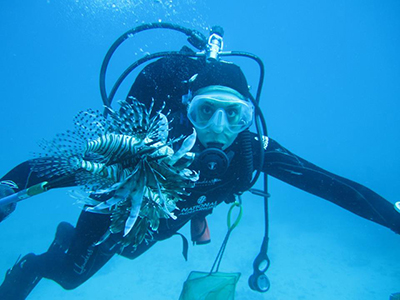 |
Close-up of Ana Zangroniz, a lionfish expert at UM’s Rosenstiel School of Marine and Atmospheric Sciences, spearing a lionfish (Photo courtesy of Biscayne National Park). |
This lionfish issue is anything but new. According to the park’s spokesperon, Matt Johnson, it’s been a hindrance since he arrived at the park four years ago. Since then, he says there have been “over 2,500 lionfish within the park that were caught and killed.”
“The lionfish have spread rapidly throughout the waters of the Caribbean and Eastern United States,” said Johnson. “They’re threats because of their appetites. They eat not only what other fish in South Florida eat, but also other fish.”
According to park biologists, lionfish are very effective predators that threaten the stability of the reefs because they “can and do eat just about anything that fits in their mouths.”
As if these issues weren’t concerning enough, Johnson also added that the lionfish “pose as competition to our native fish species for food, and they have few natural predators in the Atlantic Ocean because they’re native to the Indo-Pacific Ocean.”
There are several theories as to how lionfish, a species native to the Indo-Pacific and the Red Sea, have found their way into the waters of the Atlantic. According to the park’s scientists, lionfish are released by people who keep them as pets. When they get too big to fit in the aquarium, people then release them into the wild.
Park officials, however, also speculate that the original source for the lionfish invasion may trace all the way back to Hurricane Andrew, where they may have been released accidentally into Biscayne Bay.
| A total of 25 lionfish that were captured and killed (Photo courtesy of Biscayne National Park). | 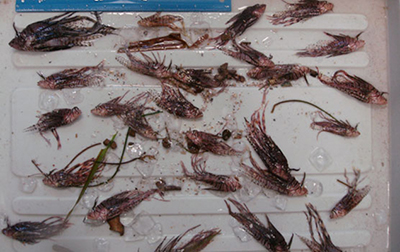 |
Various measures have been taken in hopes of better controlling the situation. According to the National Park Service, the Resource Management Division of Biscayne National Park, is enlisting the services of employees to “respond to visitor reports, assess lionfish distribution and facilitate routine monitoring and removal.”
Some of the programs and campaigns that have been launched include The Lionfish Internship Program, which sends certified divers out to catch lionfish, as well as the many free lionfish workshops held at the park.
The most recent workshop was lead by lionfish expert and graduate student at the Rosenstiel School of Marine and Atmospheric Sciences, Ana Zangroniz. The workshop covered safe handling, collecting, and diving techniques, as well as lionfish biology, ecology, and the significance and impacts of the lionfish invasion.
Catching these villainous fish requires unconventional methods that go beyond the standard net approach. Rangers and researchers have to take extra precautions due to the multitude of venomous spikes that line the lionfish’s dorsal, pelvic, and anal fins, essentially making the fish dangerous to handle on either side.
“Techniques are evolving,” Johnson stated. “There are various techniques. You can spear them or trap them in a net that closes in on them like a clam. There are also tubes that resemble PVC pipes that are used to extricate the lionfish safely.”
“The safest method involves avoiding being stung by the venomous spines of the lionfish by using SafeSpear’s polespear system, which includes the use of gloves that are puncture resistant,” said Greg Waugh, president of SafeSpear, LLC, a unique polespear system that provides safe methods for catching lionfish. The company sells their Hexarmor gloves, which Waugh said protect the palms and fingers while still providing enough flexibility to grip the polespear.
| At right, a 13-inch lionfish that was recently removed from a park reef by park biologists, and dissected to examine its gut contents. Below, a park diver collects a lionfish in a hand net (Photos courtesy of the Biscayne National Park). | 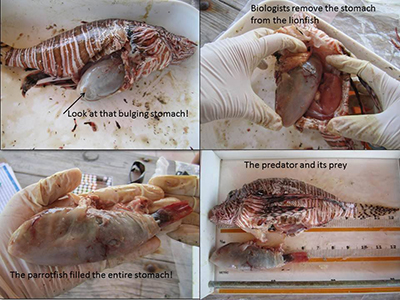 |
There has also been a large effort to cull lionfish, mainly through the use of snorkelers and divers capturing lionfish with nets or spears.
“Lionfish derbies are sponsored by many organizations throughout the region to get concentrated diver or snorkeler effort to remove lionfish,” said Dominique Lazarre, a Ph.D. student at the Rosenstiel School of Marine and Atmospheric Science at the University of Miami in the division of Marine Biology and Fisheries. “These derbies help to increase community awareness of the invasion and reduce lionfish numbers on local reefs.”
Lazarre also mentioned that studies are being conducted to investigate the effectiveness of these efforts to determine how frequently cullings need to take place.
Park biologists also stated that the best way to safely remove lionfish is “with a pole spear or Hawaiian swing, being sure to avoid direct contact.”
The park also has various interns from UM doing research on the lionfish and the many methods in practice for controlling their number in the parks. These interns are not only involved in researching gut content and biometric data, but also in testing the efficacy of lion traps.
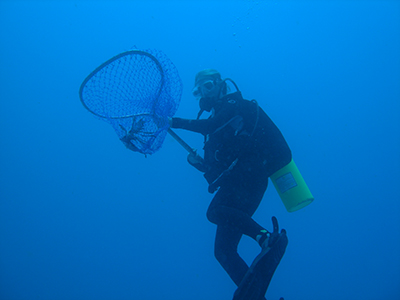 “Another intern spent her time conducting outreach events to educate over 1,000 school age children on the ecological impacts of the lionfish invasion in south Florida,” said Shelby Moneysmith, wildlife biologist and Park Dive Officer.
“Another intern spent her time conducting outreach events to educate over 1,000 school age children on the ecological impacts of the lionfish invasion in south Florida,” said Shelby Moneysmith, wildlife biologist and Park Dive Officer.
Moneysmith also mentioned that the park is working with other researchers and partners on long term monitoring studies that focus on removal efforts, recruitment rates, and fish community structure and how that affects recruitment.
Despite all these efforts, however, it may be too little too late to implement any plans that aim to entirely wipe out the lionfish population in the area, as the issue may have become rather unconquerable.
Consequently, the most plausible solution now is to attempt to control the lionfish’s numbers and the quantity of habitats they are affecting, rather than expend efforts on eliminating them completely.
“Right now, there’s really no way to eradicate them completely from the park,” Johnson lamented. “But it is a signifiant problem, and we are taking steps to eliminate as many as we can and give native fish populations a chance.”
“These studies will help park management decide how and where to focus their efforts for lionfish control,” said Moneysmith. “We realize that this is a species that is here to stay, but as Gary mentioned, there are several things that we can do to help minimize their impacts, outreach and education especially of local youth groups is very important.”
On a different and more humorous note, the park has been encouraging people to eat the lionfish, and ask for them at restaurants. The park’s Dante Fascell Visitor Center proudly displays a copy of “The Lionfish Cookbook,” at its entrance, which includes a plethora of innovative delicacies and recipes published by The Reef Environmental Foundation. Lionfish ceviche is also often served at the workshops.
As the book states, “problems create opportunities for solutions, and in this case, the solution has a culinary twist.” Proceeds from the sale of this book support REEF’s marine conservation and lionfish research activities and removal programs.
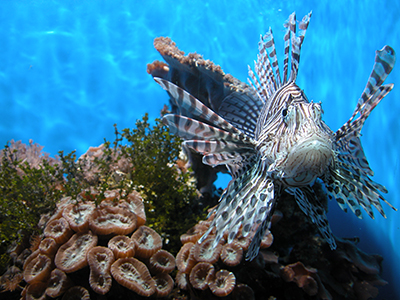 |
A close-up of a lionfish, where we can see the ornate and venomous spines and the mane-like arrangement that give the fish its lion-like appearance (Photo courtesy of stock.xchng). |
Longtime Biscayne National Park ranger, Gary Bremen, says that there are many current efforts to make lionfish a marketable commodity for consumers. They are delicious and can be served in a variety of ways – including raw as ceviche and cooked normally.
“Encouraging people to ask for the fish in restaurants is a crucial step in getting them out of our waters,” says Bremen. “Right now, it is mostly gourmet restaurants serving them as a novelty and only during lobster season when they are taken as by-catch from traps.”
Bremen also noted that if more people began to demand the fish at restaurants, restaurateurs may be inclined to ask their suppliers for the fish, which would greatly benefit the park and its ecosystems.
As Bermuda, another area targeted and threatened by lionfish presence, coined, we need to “eat ‘em to beat ‘em!”
If You Go
- Address: 9700 SW 328 St., Homestead, Fla. 33033
- Phone: For visitor information, call 305-230-PARK (305-230-7275), and for park administrative offices call 305-230-1144.
- Hours: The water portion of Biscayne National Park is open 24 hours a day, seven days a week. Adam’s Key (only accessible by boat), is a day use area only. The park’s headquarters and visitor center, Convoy Point, is open seven days a week from 7 a.m. to 5:30 p.m. The Dante Fascell Visitor Center is open daily from 9 a.m. to 4:30 p.m.
- Attractions & Activities: Canoe trips, Ranger talks (now offered via Skype as well), Fisheries Awareness Class, Family Fun Fest, underwater videos, island boat tours (with glass bottom boat), paddle-craft and canoe rentals, snorkeling, guided tours, fishing and lobstering, and displays and art exhibits.
If You Spot a Lionfish
- If you see or catch a lionfish in Biscayne National Park, please call Vanessa McDonough at 305-230-1144 ext. 027 or e-mail her at vanessa_mcdonough@nps.gov. You can also report a sighting by calling the park’s Visitor Center at 305-230-7275, ext. 000.
- It you spot a lionfish in the Biscayne National Park Area please record the following data: As precise a location as possible, including GPS coordinates if available, the size and behavior of the lionfish, and the amount found. Visitors are encouraged to report information and take photographs. However, safety precautions must always be taken as the lionfish have venomous spines that one may come into contact with when handling.
- If you happen to come into contact with one of the lionfish or are stung, the National Park Service website recommends you immerse your wound in hot water and seek medical attention as soon as possible. As mentioned previously, lionfish venom can cause severe pain, swelling, nausea, headaches, and convulsions.
For More Information:
- http://www.nps.gov/bisc/naturescience/exotic-lionfish.htm
- http://www.owuscholarship.org/blog/?p=2564
- http://www.ecreef.org/Lionfish_Pages/Documents/2013%20Lionfish%20Summit/The%20invasion%20of%20the%20Indo-Pacific%20lionfish%20in%20Biscayne%20National%20Park.pdf
- https://www.facebook.com/BiscayneNPS?fref=photo
- https://twitter.com/BiscayneNPS
- http://www.coris.noaa.gov/exchanges/lionfish/
- http://nas.er.usgs.gov/queries/FactSheet.aspx?speciesID=963

Comments are Closed